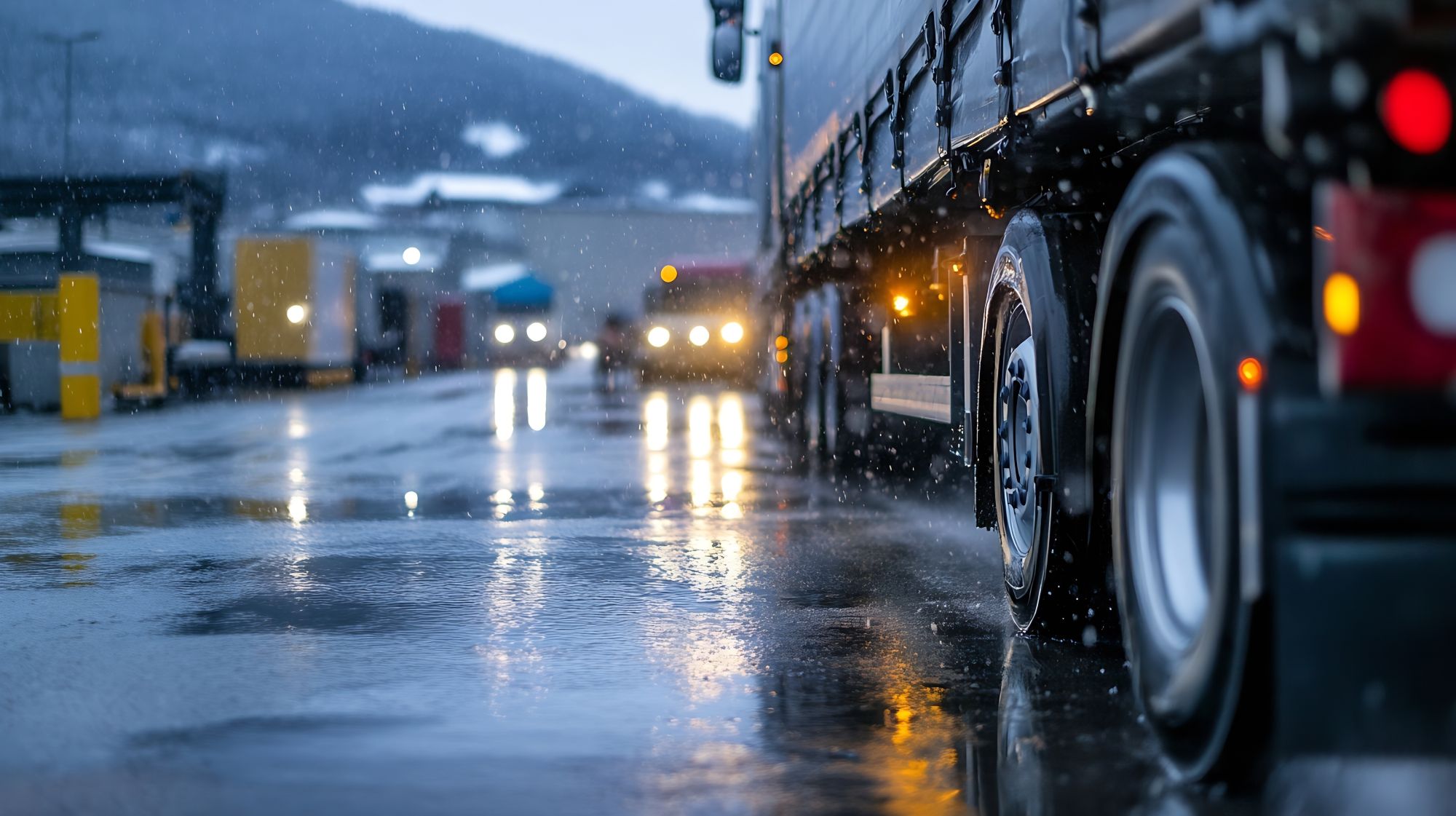
Guest
L'impact du changement climatique sur le secteur de la mobilité
Créée: 21/07/2025
•
Mise à jour : 21/07/2025
Le changement climatique n'est plus un risque lointain. Pour ceux qui travaillent dans le transport routier, il s'agit d'une réalité opérationnelle quotidienne, qu'il est de plus en plus difficile d'ignorer au fil des ans. Des vagues de chaleur qui font fondre le macadam aux inondations qui coupent les routes principales, l'impact d'un climat changeant est intégré dans l'activité de transport de marchandises.
Pour les gestionnaires de flotte, cela signifie naviguer dans des réglementations en constante évolution, mettre à jour les infrastructures et repenser la planification de la continuité. Pour les conducteurs, cela signifie qu'ils doivent s'adapter aux nouveaux risques sur la route, qu'il s'agisse de l'éclatement des pneus ou de la perturbation des fenêtres de livraison. Et pour l'ensemble du secteur, cela signifie qu'il est nécessaire d'adopter une approche de la mobilité plus résiliente et plus sensible au climat.
Les perturbations météorologiques constituent une menace opérationnelle
En juillet 2022, le Royaume-Uni a connu sa [journée la plus chaude jamais enregistrée] (https://www.theguardian.com/uk-news/2022/jul/19/uk-weather-record-hottest-day-ever-heatwave). Alors que les températures grimpaient à 40℃, les routes ont commencé à se ramollir, avec des sections de l'A14 fermées en raison de la dégradation de la surface. Les opérateurs de flottes ont été contraints de réacheminer les livraisons, parfois avec un préavis très court, tandis que les températures des moteurs montaient en flèche et que les véhicules luttaient pour maintenir leurs performances.
La même année, les vents violents de la [tempête Eunice] (https://www.theguardian.com/world/2022/feb/18/flights-and-trains-cancelled-as-storm-eunice-hits-europe) ont causé des dégâts considérables dans les couloirs de fret d'Europe occidentale, renversant des véhicules à parois hautes et endommageant des cargaisons sensibles à la température. En janvier 2024, la tempête Henk a inondé de vastes zones du centre de l'Angleterre. Les routes principales des Midlands étaient impraticables et certains conducteurs sont restés bloqués pendant des heures.
Il ne s'agit pas d'événements isolés. Ils sont le signe d'un système de transport de plus en plus vulnérable aux menaces climatiques. Les revêtements routiers, les composants des véhicules et les réseaux logistiques sont tous mis à l'épreuve par des conditions changeantes - et les conséquences se font sentir tout au long de la chaîne d'approvisionnement.
Chaînes d'approvisionnement perturbées
Lorsqu'il s'agit de perturbations liées au climat, les effets ne se font pas sentir uniquement sur les itinéraires individuels. Des chaînes d'approvisionnement entières sont touchées, parfois sans préavis. Aux Pays-Bas, l'élévation du niveau de la mer et l'augmentation des précipitations incitent les autorités et les entreprises à réévaluer la résistance des infrastructures logistiques essentielles, en particulier dans les zones industrielles de faible altitude.
Le port de Rotterdam - le plus grand port maritime d'Europe - a [pris des mesures actives] (https://www.c40.org/wp-content/uploads/2022/02/C40-Good-Practice-Guide-Climate-Change-Adaptation-in-Delta-Cities.pdf) pour s'adapter au risque climatique, en renforçant les murs de quai, en surélevant les routes d'accès et en améliorant les systèmes d'eaux pluviales pour se protéger contre les inondations. Les centres logistiques intérieurs font également l'objet d'un examen minutieux, car les conditions météorologiques extrêmes ont mis en évidence les vulnérabilités des voies d'accès et des systèmes de drainage.
L'innovation dans les transports
La technologie des flottes s'améliore rapidement, notamment en ce qui concerne l'électrification et les diagnostics intelligents. Mais le changement climatique crée de nouvelles contraintes, même pour les véhicules les plus avancés. L'efficacité des batteries peut [chuter de 20 %] (https://www.gridserve.com/how-much-range-do-electric-cars-lose-in-the-cold-and-why/) par temps froid, ce qui réduit l'autonomie effective des camionnettes électriques. Par ailleurs, les températures élevées [accélèrent la dégradation des pneus] (https://www.halfords.com/tyres/advice/tyre-pressure-in-weather.html) et mettent à rude épreuve les systèmes de refroidissement des véhicules.
Pour résoudre ces problèmes, certains opérateurs investissent dans des systèmes de maintenance prédictive qui utilisent la télématique pour anticiper l'usure et programmer les réparations avant que des pannes coûteuses ne se produisent. D'autres améliorent les systèmes de confort de la cabine pour protéger le bien-être du conducteur pendant les périodes de chaleur ou de froid extrêmes. Bien que ces changements impliquent un investissement initial, ils peuvent s'avérer payants en termes de temps de fonctionnement, de sécurité et de fidélisation des conducteurs.
L'augmentation des risques climatiques modifie également l'assurance. Certains assureurs réagissent à la fréquence accrue des sinistres liés à des conditions météorologiques extrêmes en [augmentant les primes] (https://www.insurtechinsights.com/abi-finds-extreme-weather-driving-record-claims-and-premium-increases/) et en renforçant les exclusions. Les polices d'assurance contre les pertes d'exploitation, en particulier, font l'objet d'un [examen plus approfondi] (https://www.ratcliffes.co.uk/insights/climate-risk-business-preparation), surtout lorsque les chaînes d'approvisionnement sont vulnérables à des perturbations répétées. Et si l'assurance des marchandises reste un élément à prendre en considération, toutes les polices ne couvrent pas automatiquement les retards causés par des phénomènes climatiques tels que les inondations ou les vents violents.
Les gestionnaires de flotte devraient revoir leur couverture à la lumière de ces risques émergents. Cela signifie qu'ils doivent vérifier les exclusions, évaluer la définition des événements liés au climat et s'assurer que les lacunes critiques - telles que les temps d'arrêt dus aux fermetures de routes - sont correctement prises en compte. Dans certains cas, une approche proactive de la gestion des risques, de l'atténuation des inondations et de la formation des conducteurs peut également contribuer à l'obtention de conditions plus favorables.

Le paysage réglementaire
Alors que les impacts physiques du changement climatique sont déjà visibles, les changements réglementaires ajoutent une nouvelle couche de complexité pour les opérateurs. Les zones à faibles émissions se développent rapidement au Royaume-Uni et en Europe, imposant de nouvelles exigences en matière de composition et de conformité des flottes. À Londres, la zone à très faibles émissions (ULEZ) continue de se développer, tandis que des villes comme Birmingham et Oxford ont introduit leurs propres variantes.
Au niveau européen, les paquets Green Deal et Fit for 55 ont fixé des objectifs ambitieux en matière de décarbonisation. Les exploitants de flottes sont incités - et de plus en plus contraints - à passer à des carburants et des technologies plus propres. Des mandats d'électrification aux règles de transparence de la chaîne d'approvisionnement, les opérateurs sont désormais confrontés à une nouvelle base de référence pour ce qui est considéré comme une pratique commerciale acceptable.
Pour les gestionnaires de flottes, ces changements représentent à la fois un défi logistique et une opportunité stratégique. Adopter le développement durable, ce n'est pas seulement éviter les pénalités, c'est aussi préparer l'avenir des opérations et rester à l'avant-garde des attentes changeantes des clients.
Construire des opérations résilientes
L'adaptation ne se fait pas du jour au lendemain, mais des changements progressifs peuvent avoir un impact significatif. Certains opérateurs procèdent actuellement à l'évaluation des risques climatiques dans l'ensemble de leur flotte, en identifiant les actifs et les itinéraires les plus vulnérables aux perturbations. D'autres proposent aux conducteurs une formation actualisée afin d'améliorer la sécurité et la prise de décision lors d'événements météorologiques extrêmes.
Le choix des carburants évolue également. Les transporteurs à la recherche d'alternatives plus sobres en carbone se tournent vers l'huile végétale hydrotraitée (HVO), une alternative au diesel qui réduit les émissions sans nécessiter de nouvelles infrastructures. Par ailleurs, ceux qui investissent dans des logiciels d'optimisation de la charge constatent des avantages non seulement en termes d'économie de carburant, mais aussi de réduction des émissions, ce qui leur permet d'atteindre leurs objectifs en matière de conformité.
Il ne fait plus aucun doute que le changement climatique façonne l'avenir du transport routier, non pas dans des décennies, mais dès maintenant. Le défi pour les opérateurs est de passer d'un état d'esprit réactif à un état d'esprit plus stratégique et à long terme. Cela signifie qu'il faut comprendre les risques, agir rapidement et reconnaître que la résilience devient rapidement une source d'avantage concurrentiel.
"Nous entendons la même chose de la part des opérateurs de flotte au Royaume-Uni et en Europe", déclare Nick Renton, responsable de la stratégie européenne et du développement commercial chez SNAP. "Le dérèglement climatique n'est pas un risque futur - il est déjà là, affectant tout, de l'entreposage à la planification des itinéraires en passant par le bien-être des conducteurs. Les flottes qui prospéreront seront celles qui considèrent la résilience climatique comme une stratégie commerciale, et non comme une simple réponse d'urgence.
"C'est important parce que le coût de l'inaction augmente, non seulement sur le plan financier, mais aussi en termes de livraisons manquées, de temps d'arrêt des opérations et de bien-être des conducteurs sur la route. Si nous voulons que les marchandises continuent à circuler et que les entreprises continuent à se développer, nous devons commencer à renforcer cette résilience dès maintenant".
Chez SNAP, nous travaillons en étroite collaboration avec les flottes à travers le Royaume-Uni et l'Europe pour les aider à naviguer dans cette nouvelle réalité. Que ce soit par le biais d'informations, de partenariats ou d'outils plus intelligents pour les opérations sur la route, nous sommes là pour soutenir ceux qui font tourner les roues - quel que soit le temps. [Inscrivez-vous dès aujourd'hui] (https://snapacc.com/sign-up/) pour profiter de nos solutions de gestion de flotte.



